Products You May Like
Get access to everything we publish when you
sign up for Outside+.
When Justine DeCoste, a 31-year-old from Boulder, Colorado, first received an email advertising Aire Libre’s immersive running vacations, she was skeptical. “I had traveled for races before, and I figured if I was going to travel to run for fun, I would do it on my own—I didn’t want it to be touristy,” she says.
But curiosity won out and she made a spur-of-the-moment decision to spend five days exploring Mexico City and Valle de Bravo on foot with a collection of people she very loosely knew from her days running in Boston. “It was the opposite of touristy,” she says. “We were so integrated into the local landscape and culture, I had never experienced anything like it before.”
After years of being stuck close to home, more and more travelers are seeking no-regrets experiences like this. A recent report from Expedia dubbed 2022 the year of the GOAT, or the “greatest of all trips.” Sixty-five percent of the people the company surveyed said they plan to “go big” on their next trip, and many expressed a desire to step outside their comfort zone and immerse themselves in new destinations, cultures, and experiences.
“I think there’s been this realization that if you’re thinking, someday, I’m going to do this thing, well, someday might not happen,” says Allison Macsas, the co-founder of Rogue Expeditions. “You’ve got to go do things while you can.”
For runners, that means more than just registering for a destination race (although running tourism is one of the fastest growing sectors within the global sport tourism industry). It’s a reason to splurge on trip packages that focus less on miles logged and paces clocked and more on a deeper connection with the world—and maybe even yourself.
While most running retreats aren’t gender-specific, women are registering in droves. “We don’t deliberately target women for our tours, but most of our participants—around 75 percent—are solo women,” says Mauricio Díaz, co-founder of Aire Libre. “Last year, completely unplanned, we had one tour that turned out to be entirely made up of women,” says Andy Holak, the co-owner of Adventure Running Co., a Minnesota-based company that pioneered the idea of multi-day trail running tours in the U.S.
There’s safety in numbers, but there’s also a sisterhood (or larger sense of community) that comes from group travel—especially when you’re spending all day together on the run. “I didn’t factor in the connections you make on a trip like this,” says DeCoste. “Coming out of it, we were so tight knit—and I’m still in touch with a lot of people from that group.”
RELATED: An Insider’s Guide to RunDisney’s Springtime Surprise Weekend
Ready to book your next running adventure? These five companies will take you to the ends of the earth and anywhere in between—all on your own two feet.
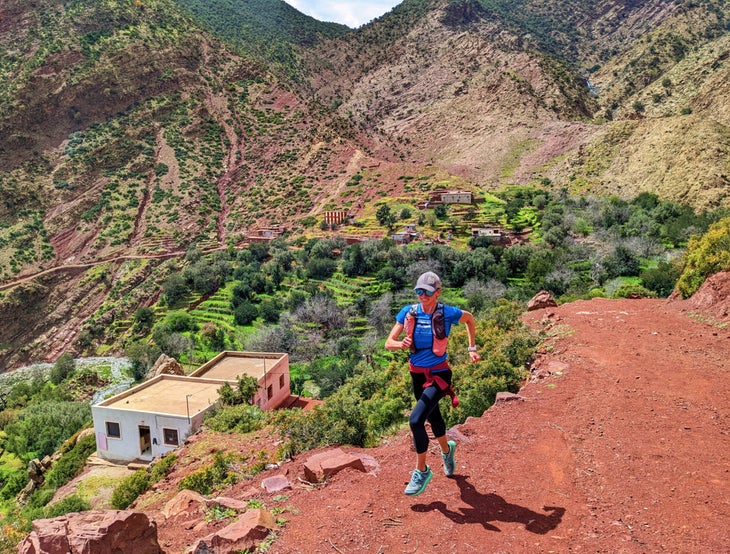
Price range: $2,950 to $5,495
Trip duration: 7 to 10 days
Upcoming trips: South Africa (October), Morocco (October and November), Kenya (2022), Patagonia (2023), Nicaragua (2023)
Imagine soaring above the ice-fields of Tweedsmuir Park in British Columbia: From your seat in the floatplane, you might see grizzly bears roaming below or catch the thundering cascade of Hunlen Falls, one of the tallest waterfalls in Canada. But, with a sharp eye, you’ll also spot the flowy single track trail winding through the high alpine terrain—a route that, just days before, you crossed by foot.
A bird’s-eye view like that is just one of the incredible travel experiences Rogue Expeditions tacks on to its running trips. “Running is the common denominator that brings everyone together,” says co-founder Allison Macsas. “But we’re using running as a vehicle for exploring a certain area and its culture.”
That means riding camels in the Moroccan desert; passing through Nicaragua’s moody cloud forest while scaling an active volcano; dining on fresh-caught fish while sailing around the coast of Croatia at sunset; recovering from runs in Iceland’s geothermal hot springs or Patagonia’s glacial rivers; and searching for lions, giraffes, and elephants on safari in Kenya’s Maasai Mara.
Because of the expedition-style nature of these trips, there is no base camp, says Macsas; the group moves every night or so—staying in family-run guesthouses, lodges, estancias, farms, and kasbahs, and indulging in local cuisine, whether that’s pints at a local Irish pub, a traditional braai (or barbecue) at an ostrich farm in South Africa, or a fresh picnic prepared on the trail in the High Atlas Mountains in Morocco.
Rogue Expeditions offers 14 different itineraries in nine different countries, all of which revolve around 10- to 12-mile running days (plus one longer run of 16 to 20 miles). Don’t let that number scare you off: “We’re there to run and use our feet to go see beautiful things,” says Macsas. “Our trips cater to all levels, and we offer a variety of distance options every day so people can choose how far they’re going to go.”
Group sizes are limited to 10 to 14 runners, and “the vast majority of people sign up solo,” says Macsas. “People bond really quickly, and it creates this team atmosphere throughout the week.” It’s an intimacy that leads to unforgettable experiences, she adds.
“We want people to go home feeling like they’ve really learned something about why a place is the way it is, and seen things they wouldn’t have been able to on their own,” says Macsas. “It’s about trying to immerse people in the full travel experience—not just the running.”
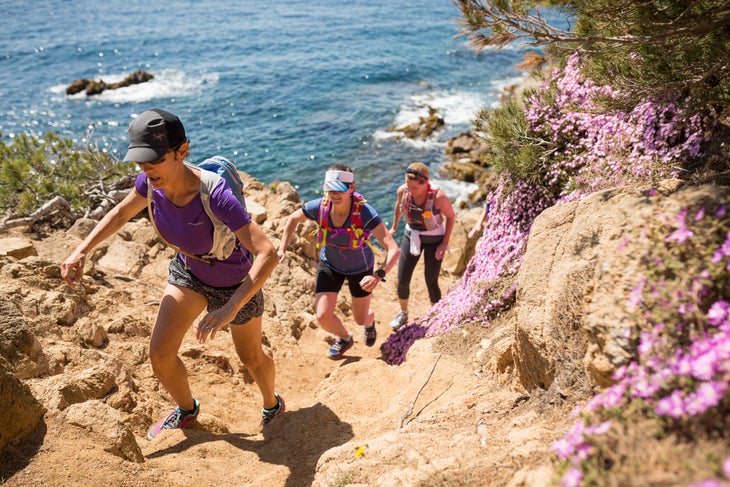
Price range: $2,195 to $5,200
Trip duration: 4 to 7 days
Upcoming trips: Telluride (September), Ireland (September), Vermont (September), Vancouver Island (October), Moab (October), Sonoran Desert (November)
For many, running doesn’t just have physical benefits—it’s a mental escape. In taking women to epic destinations, Run Wild Retreats manifests an opportunity for them to travel inward, too.
“Our goal is for people to finish the retreat feeling not exhausted because they just ran 40 miles over six days, but energized because they got to connect with people and focus on their own self-care,” says Elinor Fish, the founder of Run Wild Retreats.
The first point is why trips are limited to female runners. “When you bring together a group of just women, it makes it easier to create a sense of connection and support—and those feel-good hormones occur more powerfully,” says Fish. The second is why the company, which positions running as a kind of moving meditation, requests runners turn off GPS watches and phones to practice being fully present in their bodies while on the trail.
Runners can choose from three tiers of retreats: Level I includes 30 minutes to two and a half hours per day on undulating ground, like Moab’s rock slabs and dirt trails or the sandy beaches of the Pacific Rim National Park on Vancouver Island. Level II ups the max daily running time to four hours, with more challenging uphills and downhills—imagine a grassy and gravel coastal path leading to Ireland’s Cliffs of Moher or the rock- and root-strewn High Rockies Trail snaking through Canada’s Kananaskis Country. Level III is reserved for experienced trail runners who can handle up to five hours navigating high-altitude single-track through mountainous terrain, like the Alta Badia region of the Dolomites in Italy.
No matter what level you are, though, “it’s not about doing as many miles as possible,” says Fish. “It’s about finding a balance between time on the trail and time for yourself.”
In Iceland, after running to the top of the Skogafoss waterfall or around the Strokkur geyser, you’ll stay at Torfhús Retreat—a collection of traditional grass-roofed homes with a basalt stone hot pool heated by natural geothermal energy. In Girona, Spain, you’ll cap off a week of running along the Mediterranean with a trip to the 2,000-year-old Roman baths, complete with a one-hour private massage. And all of the retreats include gourmet meals, wellness workshops, and run coaching clinics led by professional trail-running guides.
“We’re really positioned at the intersection of adventure and wellness,” says Fish. “Our primary focus is on women’s whole wellbeing.”
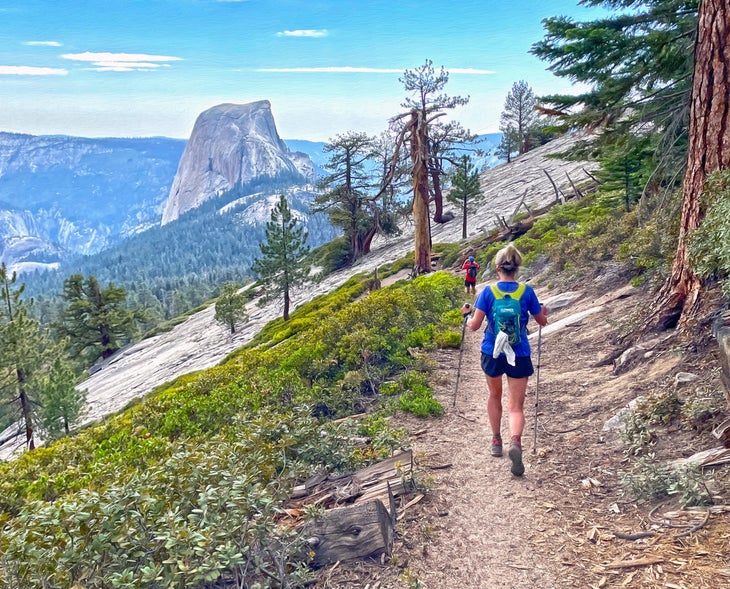
Price range: $1,295 to $2,695
Trip duration: 5 to 7 days
Upcoming trips: Newfoundland (October), Zion-Bryce (October), Cinque Terre (2023)
Certain trails are bucket list destinations all on their own. Think: navigating the open “balds” of the Appalachian Trail in North Carolina and Tennessee; picking your way over rocky outcroppings and through Aspen meadows on the Rim Trail high above Lake Tahoe; cruising past natural arches down smooth single-track lined with redrock walls from Zion National Park to Bryce Canyon National Park. Planning-wise, though, they can be a nightmare for solo trail runners.
“The idea behind our trips is trying to solve runners’ problem of having to carry all their own gear from one campsite or cabin to the next on a point-to-point trail,” says Holak, who leads tours with his wife; both are experienced trail ultramarathon runners and former backcountry and wilderness rangers. “Our supported tours allow you to really cover ground and explore the entire length of an amazing trail.”
Suddenly, pulling an international trail adventure seems easy: With professionals doing the logistical legwork, you can run The East Coast Trail along the edge of the Newfoundland in Canada, descending from fjord-like cliffs into quaint fishing villages. You can make your way through all five villages of The Cinque Terre, running high above the Mediterranean Sea on a trail once meant for mules. You can even circle the entirety of Mont Blanc on foot, passing through three different countries as you make your way from Chamonix, France through Switzerland to Courmayer, Italy.
Tours are limited to 10 runners, but cater to all levels. Not only do they frequently draw repeat customers, but they’re attracting more and more female runners, says Holak. “Generally, we average about 15 miles a day,” he says. Holak estimates timing each day based on a three-mile-per-hour pace, which leaves plenty of time for photos, meals, and even cooling tired feet off in mountain streams. “We always have a lead runner who navigates and a sweeper who makes sure we don’t lose anybody along the trail,” he says.
This kind of itinerary keeps the focus of the trip squarely on the trail as runners make their way from inn to inn, or between vacation homes and campsites (meals are provided by hosts at certain accommodations, or by guides each day). “It is mostly about running,” says Holak. “But relaxing around our campsite or in a home at the end of the day and having a few beers and talking about the day’s run—that’s a huge part of it, too.”
RELATED: Head to Austin, Texas, for Great Running
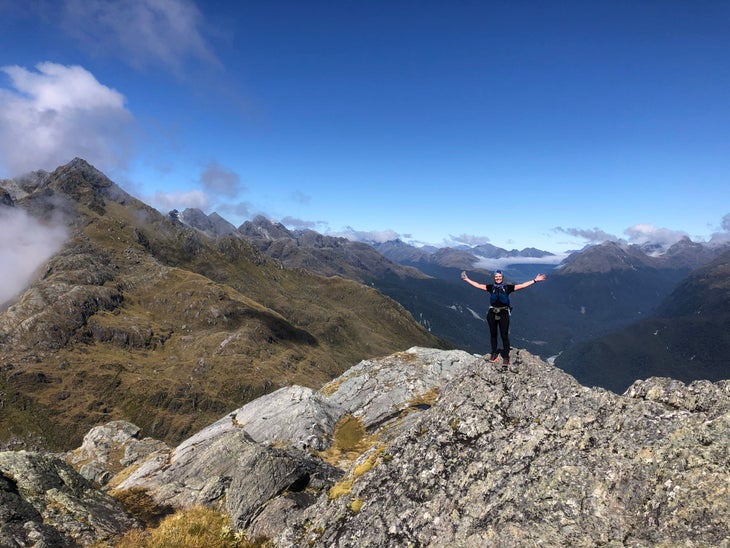
Price range: $1,995 to $6,895
Trip duration: 7 to 15 days
Upcoming trips: Bhutan (October), Madeira (October), Ecuador (November), Japan (2023), Kenya (2023), New Zealand (2023)
Running and traveling both require a willingness to push yourself out of your comfort zone. On Trail Run Adventures’ trips, “we want to go where only your feet, your energy, and your hard work can take you,” says co-owner Ron Braselton (his wife and co-owner is professional trail and ultra runner Anna Frost).
Scrambling 2,500-plus feet up el Rumiñahui in Ecuador’s Cotopaxi National Park for panoramic views or traversing 10 kilometers of technical terrain to the top of Norway’s Troll Wall may sound intimidating. But if that’s a bucket list goal for you, the guides behind Trail Run Adventures want to make it a reality.
To that end, the company requires background info for runners interested in more challenging trips, and will reach out to determine if that destination is the right one for them. “We’ll even put them on a training program if necessary,” says Braselton. “We want people to be able to test themselves on our trips, and to help them as much as we can in the process.”
Running distances can vary from a few miles per day up to 100 miles per week (there are ways to shorten some days if necessary). But mileage isn’t the only way to push your limits; trying something new could look like white water rafting around icebergs in Alaska or trying yak cheese in Bhutan, a country sandwiched between China and India. Or maybe it’s about learning new skills, like journaling, goal-setting, and more, at the women-only retreats in Telluride, Colorado, and Madeira, an archipelago off the coast of Portugal.
For runners looking to immerse themselves in more than nature, the company is adamant about using local guides to support the community and tap into their unique knowledge. In Japan—a mostly hut to hut trip through the Japanese Alps—“we eat traditional food, visit onsens, and climb Mount Fuji,” says Braselton. In Bhutan—an expedition-style trip on the Snowman Trek through the Himalaya—”you likely won’t see any other tourists, just yak herders, monasteries, and small villages cars can’t even reach,” he says.
Accommodations differ (camps in Kenya, haciendas in Ecuador, lodges in New Zealand, and hotels in Norway), but the company always pairs two people per room to keep costs down. You can pay extra for a single, “but most people enjoy staying with a new person and making a friend along the way,” says Braselton—just another way of stepping outside your comfort zone.
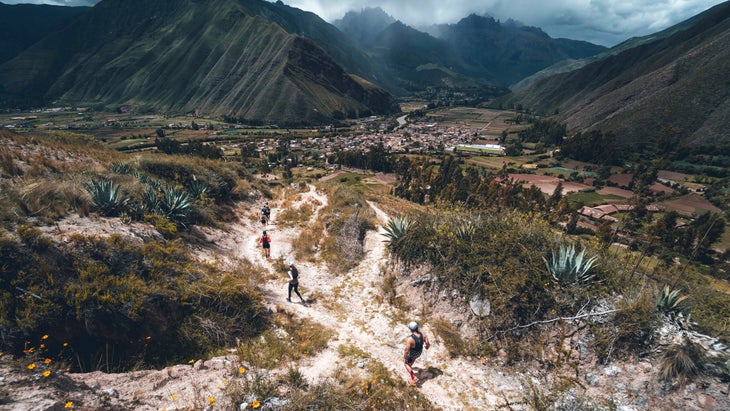
Price range: $1,400 to $4,400
Trip duration: 4 to 8 days
Upcoming trips: Scotland (September), Mexico City (September), Jackson Hole (September), Oaxaca (October), Baja California Sur (November), Patagonia (December)
Aire Libre is known for transcendental running experiences, and for good reason: The trips are based on the founders’ own experience in 2015, when they were granted permission to run through—and bring awareness to—the Seri tribe’s native land in the Sonoran desert. “That was the first time in our history as runners that we’d ever heard running could be used as a tool for greater things, beyond our own egoistic agenda of trying to run faster or farther,” says Díaz.
Now, the idea of going beyond running—or using it to explore different lands and cultures on a deeper level—is in the company’s DNA. Take the Oaxaca, Mexico retreat: Not only will you run on ancient trails used by the Zapotec in the Sierra Norte, you’ll get to celebrate the Day of the Dead in the city and participate in a traditional temazcal (or sweat lodge) ceremony. “Running for us is not the end, it’s more of the means,” says Díaz. “It’s the excuse to discover a certain area and connect with the people who live there.”
You’ll still log 4–18 miles depending on the day, but the runs are paired with local experiences that veer far from tourist traps. For example: Before the steep ascent up to Mam Barrisdale Pass in the Scottish Highlands, you’ll go for a wild swim in the loch; after a sunrise beach run in Punta Uva, Costa Rica, you’ll spend the day snorkeling in the Caribbean Sea; in Peru’s Sacred Valley, you’ll learn how to make sacred fermented drink of the Incas. Most mornings start with guided meditations that set the tone for the rest of the day, and yoga is practiced throughout the trips, adds Díaz.
Food also plays an important role, and “we try to offer a wide variety of culinary experiences, from the local kitchen of a guide’s grandmother to more modern expressions of a place’s gastronomy, like a Michelin-starred restaurant,” says Díaz. As you move between destinations, accommodations vary, from hotels to cabins to lodges to cabañas to tents, but are chosen to enhance the local experience.
“What makes our experiences so transformational is that we’re going back to our roots and practicing what makes us human,” says Díaz. “It’s moving our bodies, sharing healthy meals, opening up spaces for people to talk about emotions, practicing being present, and gaining perspective from where you are and who you’re with.”
RELATED: Ready to Dream About Travel? Pick Up These Books
